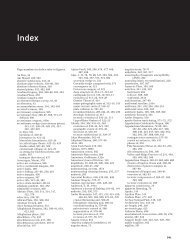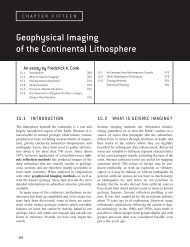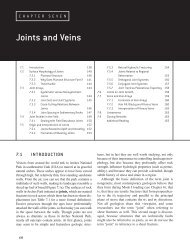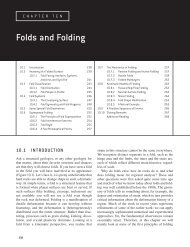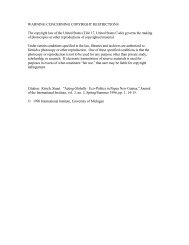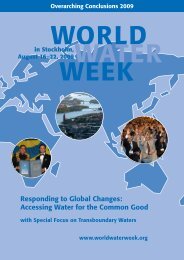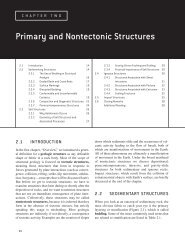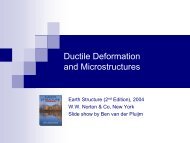The formation of an orocline by multiphase ... - ResearchGate
The formation of an orocline by multiphase ... - ResearchGate
The formation of an orocline by multiphase ... - ResearchGate
Create successful ePaper yourself
Turn your PDF publications into a flip-book with our unique Google optimized e-Paper software.
A.B. Weil et al. / Journal <strong>of</strong> Structural Geology 22 (2000) 735±756 745PL51, PL52, PL53, PL54, PL55, PL56, PL57, SL61,SL62, SL64, SL65, SL66, SL67, SL68, SL69, SL70,<strong>an</strong>d SL71 (Fig. 10a). <strong>The</strong> in-situ magnetic declinationsr<strong>an</strong>ge from easterly on the eastern limb tosoutheasterly on the western limb, with local strikehaving approximately 408 <strong>of</strong> curvature on the easternlimb. <strong>The</strong> inclinations between the 17 sites exhibitconsiderable scatter, r<strong>an</strong>ging from +328 to ±428.At 40% unfolding the inclinations clustered at ±68(kappa=18). This result is consistent with a C magnetizationacquisition that is pre-F 2 de<strong>formation</strong>. Asecond inclination-only fold test was done on the hightemperature components <strong>of</strong> sites PL49 <strong>an</strong>d PL50(Fig. 10b). <strong>The</strong>se two sites de®ne <strong>an</strong> east±west-trendingfold in the southern most section <strong>of</strong> the Viejos structure(Fig. 3). At 55% unfolding the inclinations clusteredat ±138 with a high kappa value, consistent with(C) magnetization acquisition prior to F 2 folding. Bothfold tests produce me<strong>an</strong> inclinations that are slightlydi€erent from the expected reference direction, whichwe attribute to tilting subsequent to magnetization acquisition.<strong>The</strong> third inclination-only fold test was done inthe northern section <strong>of</strong> the Viejos domain on twosites that carry the low temperature component:sites SL69 <strong>an</strong>d SL64 (Fig. 10c). At 0% unfoldingthe inclinations clustered at +138 (kappa=730).Again, the somewhat higher th<strong>an</strong> expected inclinationis attributed to tilting subsequent to magnetizationacquisition. <strong>The</strong> fact that all low temperaturesite me<strong>an</strong>s consistently exhibit less rotation awayfrom the reference direction (Table 1), coupled withthe above post-folding fold test result, suggests thatthe low temperature component found in the ViejosSyncline corresponds to a B magnetization acquiredpost-F 2 folding. Due to the scarcity <strong>of</strong> low temperature(B) components, further fold tests could not be performed.Fig. 8. Schematic 3-D drawing <strong>of</strong> the La Queta Syncline in its presentcon®guration (after Julivert <strong>an</strong>d Marcos, 1973) (a), <strong>an</strong>d correctedto its post-F 1 con®guration according to the calculated foldaxes <strong>of</strong> the north <strong>an</strong>d south La Queta structure (b). Individual beddingwas rotated according to the tilts <strong>an</strong>d rotations indicated <strong>by</strong> thedeviating site-me<strong>an</strong> directions <strong>of</strong> the magnetizations (see Table 2 forrotation parameters). After correction the La Queta synclinebecomes less contorted <strong>an</strong>d takes on a more cylindrical north±southtrend.Fig. 9. La Vega de los Viejos site-me<strong>an</strong> stereonet projections forpoles to bedding <strong>an</strong>d in-situ magnetic directions. Open symbols representupper hemisphere projections <strong>an</strong>d closed symbols representlower hemisphere projections. (a) Stereonet <strong>of</strong> in-situ site me<strong>an</strong>s forthe entire Viejos structural domain. Circles correspond to high-temperaturecomponents (C), <strong>an</strong>d squares correspond to low temperaturecomponents (B). (b) In-situ poles to bedding for the entireViejos structure with fold axis shown as black diamond. Overturnedbeds projected as upper hemisphere poles. (c) B component siteme<strong>an</strong>directions for the northern <strong>an</strong>d southern sections <strong>of</strong> the Viejosdomain with best-®t rotation axes (represented <strong>by</strong> black diamonds).Gray stars represent reference B direction. (d) <strong>The</strong> two-step C componentcorrection for those sites that carry both the B <strong>an</strong>d C magnetizations.<strong>The</strong> left stereonet shows the C components rotated withthe B magnetization leaving F 2 de<strong>formation</strong> to correct for. <strong>The</strong> rightstereonet shows the fully corrected C components after F 2 folding iscorrected for. Rotation parameters are listed in Table 3. (e) Stereographicprojections <strong>of</strong> site me<strong>an</strong>s that only carry the stable C componentfor the northern, middle <strong>an</strong>d southern sections <strong>of</strong> the Viejosdomain with best-®t rotation axes (fold axes represented <strong>by</strong> blackdiamonds). Gray stars represent reference C direction.



